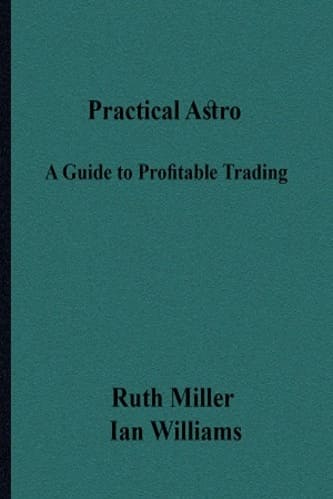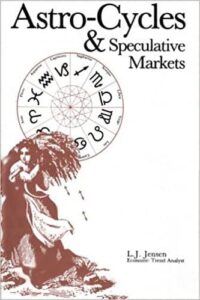Articles
Indian Astrology By Barry Rosen
If one stores up gold and silver when the Sun enters Simha (Leo) and sells them in the fifth month, he will get profit.”-Brihat Samkita (Ancient Indian text). Futures trading and financial astrology are much older than one might imagine. Over 5000 years ago, ancient Indian texts explained in great detail how to forecast and make a profit on metals, sugar and grains. Some of these seemingly simple principles still have a profound degree of usefulness today and form the historical roots of Western financial astrology. A close examination of the Indian system of astrology reveals that it has predictive power above and beyond that of Western astrology. W.D. Gann obviously realized its value since he went to India and studied it.
In the November/December issue of the G&EW, Norrnan Winski pointed out that Gann collaborated with an astrologer between 1930 and 1940 and used astrology to forecast prices. In actuality, the famous Gann wheel was first used by tea merchants in seventeenth century India. My own research into Indian astrology and its application to the financial and commodity markets has allowed me to more easily understand and apply many of Gann’s challenging concepts. More fundamentally, both Gann and the ancient astrological sages of India apparently discovered and made use of the same fundamental laws of nature governing the cosmos. In the paragraphs that follow, the fundamental differences between Indian astrology and Western astrology will be examined, and the usefulness of the Indian system for predicting the markets will be explained.
The Western Zodiac and the Indian Zodiac
The first major difference between the two systems lies in the calculation of the longitude of the planets. Ancient Indian astrologers observed that the equinoxes and solstices moved backward by one degree every 72 years, an astronomical phenomenon now known as precession. Over time this has resulted in a difference of slightly over 23 degrees between the tropical zodiac, used by Western astrologers, and the sidereal zodiac, used by Indian astrologers. In essence, the two Systems differ in their choice of a zero point for Aries — the Western system uses the position of the spring equinox, while the Indian system uses a fixed star.
Suggested Books and Courses About Astro Trading
Thus when the sun is moving into Aries according to the Western system, it is still at seven degrees Pisces in the Indian system. Practitioners of both Indian and Western astrology recognize that each system- has its own validity, since both work. My personal preference for the value of the Indian system will become clearer below.
The Nakshatra Chart: Gaining a Microscopic Perspective
The Indian system subdivides each sign into nine sections of three degrees and 20 minutes; each of these subdivisions corresponds to a sign of the zodiac. For example, the first three degrees, 20′ of Leo is the Aries subdivision, followed by the Taurus subdivision. In watching daily market strengths for over 18 months, I have observed that on days when a planet enters certain critical subdivisions, it will exert more strength or weakness depending on the financial context. So when Venus, the planet with the most impact on sugar and wheat prices, enters the Taurus subdivision of a sign, one is more likely to see sharper rises in prices if the trend and context are ripe. And when Mercury, which influences U.S. stock shares is in the Virgo subdivision, then one will see stronger bullish moves in stock prices if the context is also strong. Thus the Indian system can fine tune calls by providing more detailed daily information on planetary strengths.
The Nakshatra System of Twenty-Seven Constellations
The original Indian astrological system uses 27 constellations or nakshatras in addition to the twelve signs. The Indian constellation Mrigashira, for example, in the sign of Gemini is actually the familiar constellation Orion. According to Indian astrology each of these constellations has its own unique characteristics, much like a sign of the zodiac. Knowledge of these nakshatras can yield unique information on planetary transits and strengths. Using this system and the ancient texts, I predicted the 1988 summer drought in my April financial bulletin, due to the preponderance of critical planets in what are known as “waterless” nakshatras. Specifically, Saturn was in the constellation of Scorpii and Mars and the north node of the Moon were in the constellation of Beta Pegasi.
Planetary Periods: Beyond Transits and Progressions
According to Indian astrology, certain periods of time are governed by certain planets. These planetary periods, or mahadasas, occur in a specific sequence and last for a specific length of time. However, the starting point of the sequence is unique to the particular chart being analyzed, and depends on the nakshatra that the Moon occupies in the chart. Based on the chart of the New York Stock Exchange (established in 1792), I determined that the stock market entered a sixteen year Jupiter period in August, 1982. This coincided with the start of the bull market. In general then, according to this system the market will continue to expand until 1998, since Jupiter is a “bullish” planet. Rises and falls within the current Jupiter mahadasa are explained by sub-periods, or antardasas. These sub-periods can either amplify or diminish the strength of the major period.
For those technicians interested in explaining alternative Elliott Wave counts, the Indian system of planetary cycles offers a means of gauging the quality of the waves, timing them, and understanding when a wave count is complete because a new cycle has started. Indian dashas are a unique type of cycle that cannot be compared with Gann cycles. The concept of Indian time is that of a spiral, and sections within Indian cycles behave in a Fibonacci-like manner.
Indian Aspects: Angular Relationships Between Planets
Indian astrology, like Western astrology, includes aspects, the angular relationships between planets. The Indian and Western systems differ, however, since in Indian astrology each planet aspects other planets in a unique way. When Jupiter, for example, forms 120 or 240 degree aspects (trines) with another planet, the effect is strong, but if the aspect is 90 or 210 degree aspects, while trines involving Mars are relatively weak. Saturn’s strongest aspects are 60 and 270 degrees. Conjunctions (0 degrees) and oppositions (180 degrees) are strong for all planets.
These concepts were illustrated on October 28, 1988 when Mars formed a 270 degree aspect to Saturn and Uranus. Many prognosticators expected a significant market effect due to the Western square, but the effect turned out to be negligible. Indian astrology explains this non-event since squares involving Mars are only strong when they are counter-clockwise (a 90 degree aspect); clockwise squares involving Mars (a 270 degree aspect) are very weak. And the Saturn aspect was actually a 90 degree aspect rather than a 270 degree one, which again according to Indian astrology is considered weak. Upon discovering the ancient Indian text quoted at the beginning of this article, the expression, “there’s nothing new under the sun” came to mind. I felt that the most fundamental laws of nature governing commodities are actually the same laws that govern both the movements of the solar system and the depths of human psychology.
Anyone attempting to uncover the mysterious laws of nature that underlie the commodity markets will be rewarded and intrigued by the depths of Indian astrology. The study of Indian astrology leads not only to knowledge of economic laws, but ultimately to knowledge of the self. On a more practical level, while no astrological system should be used 100 percent to time market entries and exits, a combination of astrological and technical signals can certainly stack the odds in your favor.




